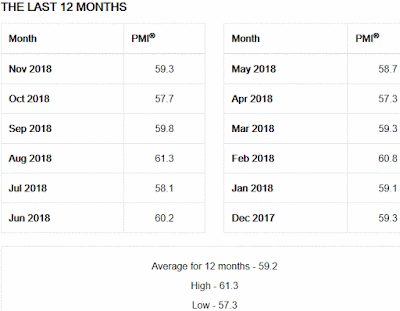The
Consumer Confidence Index® (CCI) for this month (December 2018) was
released by
The Conference Board® this morning:
Predicted: 134.0
Actual: 128.1
================
Previous Month (revised):
136.4.
==========
The "predicted" figure is what economists were expecting, while the "actual" is the true or real figure.
From Today's Report:
"...'Consumer Confidence decreased in December, following a moderate decline in November,' said Lynn Franco, Senior Director of Economic Indicators at The Conference Board. 'Expectations regarding job prospects and business conditions weakened, but still suggest that the economy will continue expanding at a solid pace in the short-term. While consumers are ending 2018 on a strong note, back-to-back declines in Expectations are reflective of an increasing concern that the pace of economic growth will begin moderating in the first half of 2019.'
Consumers’ assessment of current conditions declined slightly in December. The percentage of consumers saying business conditions are 'good' decreased from 42.0 percent to 37.2 percent, while those claiming business conditions are 'bad' increased from 10.7 percent to 11.3 percent. Consumers’ assessment of the labor market was mixed. Those claiming jobs are 'plentiful' decreased marginally from 46.8 percent to 46.2 percent, while those claiming jobs are 'hard to get' declined from 12.6 percent to 11.6 percent.
Consumers’ optimism about the short-term future fell in December. The percentage of consumers expecting business conditions will improve over the next six months decreased from 21.9 percent to 18.3 percent, while those expecting business conditions will worsen increased, from 8.3 percent to 9.7 percent.
Consumers’ outlook for the labor market was also less favorable. The proportion expecting more jobs in the months ahead decreased from 22.7 percent to 16.6 percent, while those anticipating fewer jobs increased, from 11.2 percent to 14.4 percent. Regarding their short-term income prospects, the percentage of consumers expecting an improvement declined from 23.2 percent to 22.4 percent, while the proportion expecting a decrease rose, from 7.2 percent to 7.7 percent..."
Every month, The Conference Board sends a questionnaire to 5,000 U.S. households. Survey participants are polled about their feelings regarding the U.S. economy, current and future, and about their own fiscal circumstances. On average, 3,500 participants complete and return the 5-question survey.
- The baseline "100" score for the CCI is associated with 1985 survey data.
When consumers feel good about the economy, they tend to do more spending, and vice versa.
Based in New York City, The Conference Board is a private, not-for-profit organization with a mission to, "create and disseminate knowledge about management and the marketplace to help businesses strengthen their performance and better serve society."
The CCI is usually released on the last Tuesday of the month.
=====================
=====================
Labels: cci, consumer_confidence, consumers, soft_data







